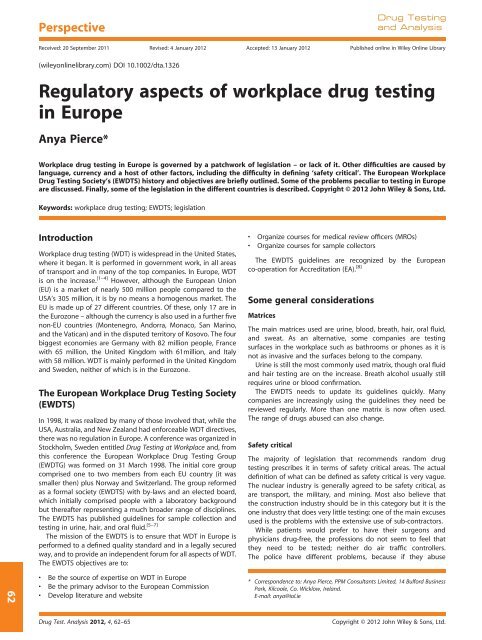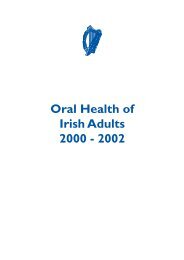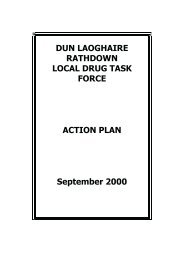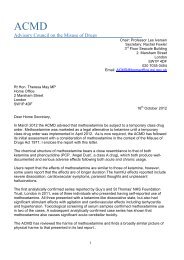Regulatory aspects of workplace drug testing in Europe
Regulatory aspects of workplace drug testing in Europe
Regulatory aspects of workplace drug testing in Europe
You also want an ePaper? Increase the reach of your titles
YUMPU automatically turns print PDFs into web optimized ePapers that Google loves.
62<br />
Perspective<br />
<strong>Regulatory</strong> <strong>aspects</strong> <strong>of</strong> <strong>workplace</strong> <strong>drug</strong> <strong>test<strong>in</strong>g</strong><br />
<strong>in</strong> <strong>Europe</strong><br />
Anya Pierce*<br />
Workplace <strong>drug</strong> <strong>test<strong>in</strong>g</strong> <strong>in</strong> <strong>Europe</strong> is governed by a patchwork <strong>of</strong> legislation – or lack <strong>of</strong> it. Other difficulties are caused by<br />
language, currency and a host <strong>of</strong> other factors, <strong>in</strong>clud<strong>in</strong>g the difficulty <strong>in</strong> def<strong>in</strong><strong>in</strong>g ‘safety critical’. The <strong>Europe</strong>an Workplace<br />
Drug Test<strong>in</strong>g Society’s (EWDTS) history and objectives are briefly outl<strong>in</strong>ed. Some <strong>of</strong> the problems peculiar to <strong>test<strong>in</strong>g</strong> <strong>in</strong> <strong>Europe</strong><br />
are discussed. F<strong>in</strong>ally, some <strong>of</strong> the legislation <strong>in</strong> the different countries is described. Copyright © 2012 John Wiley & Sons, Ltd.<br />
Keywords: <strong>workplace</strong> <strong>drug</strong> <strong>test<strong>in</strong>g</strong>; EWDTS; legislation<br />
Introduction<br />
Workplace <strong>drug</strong> <strong>test<strong>in</strong>g</strong> (WDT) is widespread <strong>in</strong> the United States,<br />
where it began. It is performed <strong>in</strong> government work, <strong>in</strong> all areas<br />
<strong>of</strong> transport and <strong>in</strong> many <strong>of</strong> the top companies. In <strong>Europe</strong>, WDT<br />
is on the <strong>in</strong>crease. [1–4] However, although the <strong>Europe</strong>an Union<br />
(EU) is a market <strong>of</strong> nearly 500 million people compared to the<br />
USA’s 305 million, it is by no means a homogenous market. The<br />
EU is made up <strong>of</strong> 27 different countries. Of these, only 17 are <strong>in</strong><br />
the Eurozone – although the currency is also used <strong>in</strong> a further five<br />
non-EU countries (Montenegro, Andorra, Monaco, San Mar<strong>in</strong>o,<br />
and the Vatican) and <strong>in</strong> the disputed territory <strong>of</strong> Kosovo. The four<br />
biggest economies are Germany with 82 million people, France<br />
with 65 million, the United K<strong>in</strong>gdom with 61million, and Italy<br />
with 58 million. WDT is ma<strong>in</strong>ly performed <strong>in</strong> the United K<strong>in</strong>gdom<br />
and Sweden, neither <strong>of</strong> which is <strong>in</strong> the Eurozone.<br />
The <strong>Europe</strong>an Workplace Drug Test<strong>in</strong>g Society<br />
(EWDTS)<br />
In 1998, it was realized by many <strong>of</strong> those <strong>in</strong>volved that, while the<br />
USA, Australia, and New Zealand had enforceable WDT directives,<br />
there was no regulation <strong>in</strong> <strong>Europe</strong>. A conference was organized <strong>in</strong><br />
Stockholm, Sweden entitled Drug Test<strong>in</strong>g at Workplace and, from<br />
this conference the <strong>Europe</strong>an Workplace Drug Test<strong>in</strong>g Group<br />
(EWDTG) was formed on 31 March 1998. The <strong>in</strong>itial core group<br />
comprised one to two members from each EU country (it was<br />
smaller then) plus Norway and Switzerland. The group reformed<br />
as a formal society (EWDTS) with by-laws and an elected board,<br />
which <strong>in</strong>itially comprised people with a laboratory background<br />
but thereafter represent<strong>in</strong>g a much broader range <strong>of</strong> discipl<strong>in</strong>es.<br />
The EWDTS has published guidel<strong>in</strong>es for sample collection and<br />
<strong>test<strong>in</strong>g</strong> <strong>in</strong> ur<strong>in</strong>e, hair, and oral fluid. [5–7]<br />
The mission <strong>of</strong> the EWDTS is to ensure that WDT <strong>in</strong> <strong>Europe</strong> is<br />
performed to a def<strong>in</strong>ed quality standard and <strong>in</strong> a legally secured<br />
way, and to provide an <strong>in</strong>dependent forum for all <strong>aspects</strong> <strong>of</strong> WDT.<br />
The EWDTS objectives are to:<br />
Be the source <strong>of</strong> expertise on WDT <strong>in</strong> <strong>Europe</strong><br />
Be the primary advisor to the <strong>Europe</strong>an Commission<br />
Develop literature and website<br />
Organize courses for medical review <strong>of</strong>ficers (MROs)<br />
Organize courses for sample collectors<br />
The EWDTS guidel<strong>in</strong>es are recognized by the <strong>Europe</strong>an<br />
co-operation for Accreditation (EA). [8]<br />
Some general considerations<br />
Matrices<br />
The ma<strong>in</strong> matrices used are ur<strong>in</strong>e, blood, breath, hair, oral fluid,<br />
and sweat. As an alternative, some companies are <strong>test<strong>in</strong>g</strong><br />
surfaces <strong>in</strong> the <strong>workplace</strong> such as bathrooms or phones as it is<br />
not as <strong>in</strong>vasive and the surfaces belong to the company.<br />
Ur<strong>in</strong>e is still the most commonly used matrix, though oral fluid<br />
and hair <strong>test<strong>in</strong>g</strong> are on the <strong>in</strong>crease. Breath alcohol usually still<br />
requires ur<strong>in</strong>e or blood confirmation.<br />
The EWDTS needs to update its guidel<strong>in</strong>es quickly. Many<br />
companies are <strong>in</strong>creas<strong>in</strong>gly us<strong>in</strong>g the guidel<strong>in</strong>es they need be<br />
reviewed regularly. More than one matrix is now <strong>of</strong>ten used.<br />
The range <strong>of</strong> <strong>drug</strong>s abused can also change.<br />
Safety critical<br />
Drug Test<strong>in</strong>g<br />
and Analysis<br />
Received: 20 September 2011 Revised: 4 January 2012 Accepted: 13 January 2012 Published onl<strong>in</strong>e <strong>in</strong> Wiley Onl<strong>in</strong>e Library<br />
(wileyonl<strong>in</strong>elibrary.com) DOI 10.1002/dta.1326<br />
The majority <strong>of</strong> legislation that recommends random <strong>drug</strong><br />
<strong>test<strong>in</strong>g</strong> prescribes it <strong>in</strong> terms <strong>of</strong> safety critical areas. The actual<br />
def<strong>in</strong>ition <strong>of</strong> what can be def<strong>in</strong>ed as safety critical is very vague.<br />
The nuclear <strong>in</strong>dustry is generally agreed to be safety critical, as<br />
are transport, the military, and m<strong>in</strong><strong>in</strong>g. Most also believe that<br />
the construction <strong>in</strong>dustry should be <strong>in</strong> this category but it is the<br />
one <strong>in</strong>dustry that does very little <strong>test<strong>in</strong>g</strong>: one <strong>of</strong> the ma<strong>in</strong> excuses<br />
used is the problems with the extensive use <strong>of</strong> sub-contractors.<br />
While patients would prefer to have their surgeons and<br />
physicians <strong>drug</strong>-free, the pr<strong>of</strong>essions do not seem to feel that<br />
they need to be tested; neither do air traffic controllers.<br />
The police have different problems, because if they abuse<br />
* Correspondence to: Anya Pierce, PPM Consultants Limited, 14 Bulford Bus<strong>in</strong>ess<br />
Park, Kilcoole, Co. Wicklow, Ireland.<br />
E-mail: anya@iol.ie<br />
Drug Test. Analysis 2012, 4, 62–65 Copyright © 2012 John Wiley & Sons, Ltd.
Anya Pierce, PPM Consultants Limited, Ireland<br />
<strong>drug</strong>s they may be prosecuted, which is not the case for the<br />
general population.<br />
Another debate concerns whether, if safety critical workers are<br />
tested, their co-workers should be, too. The Swedish court case,<br />
referred to below, seems to imply that they should.<br />
Other problems and traps for the unwary<br />
While the EWDTS guidel<strong>in</strong>es are used by the EA, it would be<br />
preferable to have enforceable directives that operate throughout<br />
<strong>Europe</strong> and are the same <strong>in</strong> every country. In the absence<br />
<strong>of</strong> legislation, the guidel<strong>in</strong>es need to be updated and expanded.<br />
As was seen earlier, there are different laws <strong>in</strong> different<br />
countries. For example, small amounts <strong>of</strong> cannabis can be legally<br />
used <strong>in</strong> the Netherlands. There is also an <strong>in</strong>creas<strong>in</strong>g <strong>in</strong>terest <strong>in</strong> the<br />
use <strong>of</strong> medical cannab<strong>in</strong>oids across <strong>Europe</strong>, particularly <strong>in</strong> the UK<br />
and Ireland.<br />
In the USA, there is only one <strong>of</strong>ficial language. A major problem<br />
<strong>in</strong> <strong>Europe</strong> is the huge variety <strong>of</strong> languages. As much WDT<br />
orig<strong>in</strong>ates <strong>in</strong> the USA, many <strong>of</strong> the forms and explanations used<br />
are <strong>in</strong> English. The person be<strong>in</strong>g tested may not understand<br />
English, which can lead to severe miscommunication.<br />
The date can also cause difficulties as <strong>in</strong> <strong>Europe</strong> the day/<br />
month/year (dd/mm/yy) is typical whereas <strong>in</strong> the USA the format<br />
mm/dd/yy is used. It is therefore important to write the full date<br />
such as 8 January 2011.<br />
Across <strong>Europe</strong> there are large differences <strong>in</strong> standards: liv<strong>in</strong>gs<br />
standards, healthcare, and health and safety at work. Quality<br />
issues and laboratory accreditation are not the same for each<br />
country. There are also cultural differences: for example, most<br />
French and Nordic <strong>in</strong>habitants take their vacations <strong>in</strong> the month<br />
<strong>of</strong> August so it is difficult to schedule <strong>test<strong>in</strong>g</strong> <strong>in</strong> this month.<br />
Different public holidays create further problems.<br />
In many cases, the <strong>in</strong>itial screen<strong>in</strong>g test is performed <strong>in</strong> one<br />
country while the confirmation is done <strong>in</strong> another country. This<br />
can give rise to problems <strong>in</strong> collect<strong>in</strong>g the specimens. The<br />
different processes used <strong>in</strong> the different laboratories and <strong>in</strong><br />
the transport <strong>in</strong>volved can make it easier for challenges from<br />
the legal community. This can all make it more difficult to have<br />
a clear cha<strong>in</strong> <strong>of</strong> custody.<br />
It is also generally more expensive to test for <strong>drug</strong>s <strong>in</strong> <strong>Europe</strong>.<br />
There are few economies <strong>of</strong> scale. Payments may be <strong>in</strong> different<br />
currencies which, with currency fluctuations – particularly at the<br />
moment – creates difficulties, with more bureaucracy and delays.<br />
The lack <strong>of</strong> tra<strong>in</strong>ed personnel is also problematic. While <strong>in</strong><br />
some countries there are a few courses available for collectors,<br />
<strong>in</strong> many there are none. Collectors need tra<strong>in</strong><strong>in</strong>g <strong>in</strong> their own<br />
language as they may miss important nuances if learn<strong>in</strong>g <strong>in</strong> a<br />
second language. In many countries occupational physicians take<br />
on the role <strong>of</strong> Medical Review Officer (MRO) but do not possess<br />
the necessary skills and tra<strong>in</strong><strong>in</strong>g (and with the same language<br />
problem <strong>in</strong> arrang<strong>in</strong>g tra<strong>in</strong><strong>in</strong>g).<br />
In the USA, <strong>drug</strong> <strong>test<strong>in</strong>g</strong> statistics are available but not so <strong>in</strong><br />
<strong>Europe</strong>. There is very little reliable data and there is an aura <strong>of</strong><br />
secrecy. Overall more openness is needed as well as pan-<strong>Europe</strong>an<br />
directives on all <strong>aspects</strong> <strong>of</strong> <strong>test<strong>in</strong>g</strong> from collections to the f<strong>in</strong>al report.<br />
Regulation outside <strong>Europe</strong><br />
The USA, Australia and New Zealand have strict directives which<br />
must be observed.<br />
USA<br />
Drug tests <strong>in</strong> the USA can be divided <strong>in</strong>to two general groups:<br />
federally and non-federally regulated <strong>test<strong>in</strong>g</strong>. Drug <strong>test<strong>in</strong>g</strong><br />
guidel<strong>in</strong>es and processes are established and regulated by the<br />
Substance Abuse and Mental Health Services Adm<strong>in</strong>istration<br />
(SAMHSA). [9] The Department <strong>of</strong> Transportation (DOT) also tests<br />
frequently with many <strong>of</strong> the top companies also <strong>test<strong>in</strong>g</strong> randomly.<br />
Australia and New Zealand<br />
In Australia and New Zealand, the requirements for <strong>workplace</strong> <strong>drug</strong><br />
and alcohol <strong>test<strong>in</strong>g</strong> are stipulated <strong>in</strong> Australian Standards: [10]<br />
The Australian Ur<strong>in</strong>e Drug Test<strong>in</strong>g Standard AS4308:2008<br />
The Australian Saliva Drug Test<strong>in</strong>g Standard AS4760:2006<br />
Regulation <strong>in</strong> <strong>Europe</strong><br />
In <strong>Europe</strong>, any regulation must conform to the Convention for<br />
the Protection <strong>of</strong> Human Rights and Fundamental Freedoms<br />
(commonly known as the <strong>Europe</strong>an Convention on Human<br />
Rights (ECHR)) which provides for a person’s right to privacy,<br />
which states that everyone has the right to his private and family<br />
life, his home and his correspondence and that public authorities<br />
must not <strong>in</strong>terfere with the exercise <strong>of</strong> this right ‘except such as is<br />
<strong>in</strong> accordance with the law and is necessary <strong>in</strong> a democratic<br />
society <strong>in</strong> the <strong>in</strong>terests <strong>of</strong> national security, public safety or the<br />
economic well-be<strong>in</strong>g <strong>of</strong> the country, for the prevention <strong>of</strong><br />
disorder or crime, for the protection <strong>of</strong> health or morals, or for<br />
the protection <strong>of</strong> the rights and freedoms <strong>of</strong> others’. [11]<br />
The legislation <strong>in</strong> the various countries is summarized below. [9]<br />
F<strong>in</strong>land<br />
The 2004 Act on Workplace Drug Test<strong>in</strong>g (759/2004) ss.7–8 allows<br />
WDT which must be paid for by the employer. It is only allowed<br />
<strong>in</strong> def<strong>in</strong>ed circumstances, where <strong>in</strong>toxication or addiction may<br />
endanger life, health, national or traffic safety, security <strong>of</strong> <strong>in</strong>formation<br />
<strong>in</strong> the public <strong>in</strong>terest, or bus<strong>in</strong>ess or pr<strong>of</strong>essional confidentiality.<br />
Before the law was enacted, the armed forces were tested but<br />
after its enact<strong>in</strong>g, this was deemed illegal.<br />
Sweden<br />
Drug Test<strong>in</strong>g<br />
and Analysis<br />
An <strong>in</strong>terest<strong>in</strong>g piece <strong>of</strong> case law governs WDT <strong>in</strong> Sweden. A<br />
cleaner was employed s<strong>in</strong>ce 1986 <strong>in</strong> a nuclear plant. There were<br />
four unions <strong>in</strong> the plant and three <strong>of</strong> the unions agreed to allow<br />
<strong>test<strong>in</strong>g</strong> <strong>of</strong> their members. Her union did not agree. In 1996, the<br />
union went to the Labour Court. The cleaner did not work <strong>in</strong><br />
the nuclear plant itself but <strong>in</strong> an adm<strong>in</strong>istrative block. The Court<br />
felt that work<strong>in</strong>g <strong>in</strong> a nuclear plant <strong>in</strong>creased the need for WDT<br />
and ruled that the applicant must submit to a <strong>drug</strong> test but<br />
was not obliged to submit to an alcohol test.<br />
The case was referred to <strong>Europe</strong>an Court <strong>of</strong> Human Rights, which<br />
gave its judgement on 9 March 2004. It ruled that a very high level<br />
<strong>of</strong> security was needed <strong>in</strong> a nuclear plant as it is so safety critical.<br />
Drug use could jeopardize security. While the cleaner did not<br />
normally work <strong>in</strong> the safety critical area it would be impractical to<br />
differentiate employees and the application was rejected.<br />
WDT <strong>in</strong> Sweden is <strong>in</strong>creas<strong>in</strong>g. Indeed, Volvo, a car manufacturer,<br />
tests at all <strong>of</strong> its facilities worldwide. New regulations <strong>in</strong><br />
Sweden s<strong>in</strong>ce 2010 have <strong>in</strong>troduced random <strong>test<strong>in</strong>g</strong> at airports.<br />
Drug Test. Analysis 2012, 4, 62–65 Copyright © 2012 John Wiley & Sons, Ltd. wileyonl<strong>in</strong>elibrary.com/journal/dta<br />
63
64<br />
Drug Test<strong>in</strong>g<br />
and Analysis<br />
All employees work<strong>in</strong>g on the airside <strong>in</strong> airports are subject to<br />
random <strong>test<strong>in</strong>g</strong>. Even <strong>in</strong>com<strong>in</strong>g flights are subjects to random<br />
<strong>test<strong>in</strong>g</strong>. That is unique <strong>in</strong> <strong>Europe</strong>. At Stockholm airport, the police<br />
perform about 1500 random tests per year airside. For many<br />
years, the air traffic controllers have also been <strong>drug</strong> tested<br />
randomly <strong>in</strong> Sweden.<br />
France<br />
The M<strong>in</strong>istry <strong>of</strong> Transport Act, 30 July, 2003 provides for a<br />
biological exam<strong>in</strong>ation conducted by an occupational doctor to<br />
detect psychoactive substances for certa<strong>in</strong> positions <strong>in</strong> the<br />
national railway system. In fact SNCF, the national rail company,<br />
tests but does not fire staff that test positive; they are merely<br />
redeployed to a non-safety critical post.<br />
It usually depends on the <strong>in</strong>cl<strong>in</strong>ation <strong>of</strong> the occupational<br />
physician whether to test or not: for example Renault, a car<br />
manufacturer, does, while Peugeot, another, does not.<br />
The Netherlands<br />
Pre-employment <strong>drug</strong> <strong>test<strong>in</strong>g</strong> <strong>of</strong> all applicants is prohibited by<br />
law; however <strong>test<strong>in</strong>g</strong> <strong>of</strong> the successful applicant is permitted <strong>in</strong><br />
certa<strong>in</strong> circumstances<br />
The employee has the right <strong>of</strong> refusal and no negative conclusion<br />
can be formed from this.<br />
Italy<br />
An act came <strong>in</strong>to effect <strong>in</strong> September 2008 which def<strong>in</strong>ed the<br />
safety critical situations <strong>in</strong> which <strong>workplace</strong> <strong>test<strong>in</strong>g</strong> is mandatory<br />
and/or admissible. [12] Two matrices, ur<strong>in</strong>e and hair, are collected.<br />
Forty to sixty millilitres <strong>of</strong> ur<strong>in</strong>e, which is quite a large amount, is<br />
(attempted to be) collected and is split three ways: two for<br />
screen<strong>in</strong>g and confirmation and a third that can be sent to<br />
another laboratory for an alternative analysis. Adherence to the<br />
regulations is more common <strong>in</strong> the north than the south <strong>of</strong> Italy.<br />
Random <strong>test<strong>in</strong>g</strong> should be a surprise, but sometimes <strong>in</strong> the south<br />
<strong>of</strong> the country a few weeks’ notice is given. Rehabilitation is a<br />
large part <strong>of</strong> this programme<br />
United K<strong>in</strong>gdom<br />
The Independent Inquiry <strong>in</strong>to Drug Test<strong>in</strong>g at Work did not<br />
recommend a national regulation on <strong>test<strong>in</strong>g</strong>. Rather it recommended<br />
that the government should produce clear and def<strong>in</strong>itive guidance<br />
on <strong>drug</strong> <strong>test<strong>in</strong>g</strong> at work and particularly on the legal issues.<br />
The UK did, however, set standards for <strong>test<strong>in</strong>g</strong> <strong>in</strong> the railways<br />
(UKRailway Group standards GE/RT 8070 and RT/LS/P/051;<br />
superseded by GE/RT8070). [13] These state that screen<strong>in</strong>g for<br />
<strong>drug</strong>s can take place randomly with at least 5% <strong>of</strong> staff be<strong>in</strong>g<br />
tested annually, and on a ‘for cause’ basis follow<strong>in</strong>g an accident.<br />
Written notice <strong>of</strong> a random sample will not be given prior to<br />
sampl<strong>in</strong>g. Refusal to take a random alcohol and <strong>drug</strong>s test will<br />
result <strong>in</strong> a positive result be<strong>in</strong>g recorded.<br />
Ireland<br />
The Health and Safety at Work Act 2005 [14] requires that, <strong>in</strong><br />
safety critical areas, an employee ensures that he or she is not<br />
under the <strong>in</strong>fluence <strong>of</strong> an <strong>in</strong>toxicant to the extent that he or<br />
she is <strong>in</strong> such a state as to endanger his or her own safety, health<br />
or welfare at work or that <strong>of</strong> any other person. ‘Intoxicant’<br />
<strong>in</strong>cludes alcohol and <strong>drug</strong>s and any comb<strong>in</strong>ation <strong>of</strong> <strong>drug</strong>s or <strong>of</strong><br />
<strong>drug</strong>s and alcohol. The employee also, if reasonably required by<br />
his or her employer, must submit to any appropriate, reasonable,<br />
and proportionate tests, by or under the supervision <strong>of</strong> a<br />
registered medical practitioner.<br />
It also puts the onus on the employer to ensure a safe<br />
<strong>workplace</strong>. The Health and Safety Authority had planned to issue<br />
further guidel<strong>in</strong>es on implementation but has s<strong>in</strong>ce changed its<br />
m<strong>in</strong>d. The Attorney General (the senior lawyer who advises the<br />
government) has ruled that employers cannot enforce <strong>test<strong>in</strong>g</strong><br />
until legislation <strong>in</strong> place. This means that, at present, although<br />
the Act is there, the implementation is still not def<strong>in</strong>ed.<br />
Similar to the UK, Ireland has brought <strong>in</strong> a railway act (The<br />
Railway Safety Act, 2005). It makes specific provision for random<br />
<strong>test<strong>in</strong>g</strong> <strong>of</strong> safety critical workers. Intoxicant <strong>in</strong> this Act has the<br />
same def<strong>in</strong>ition as the Safety, Health and Welfare at Work Act,<br />
2005. It def<strong>in</strong>es safety critically workers as persons who perform<br />
safety critical tasks <strong>in</strong>clud<strong>in</strong>g driv<strong>in</strong>g a tra<strong>in</strong>, controll<strong>in</strong>g the<br />
movement <strong>of</strong> persons on a tra<strong>in</strong>, or work<strong>in</strong>g <strong>in</strong> a ma<strong>in</strong>tenance capacity.<br />
This Act applies to safety critical workers on the rail and<br />
tramways.<br />
One piece <strong>of</strong> case law has come from this Act: The driver <strong>of</strong> a<br />
tram screened positive for cannabis. The ur<strong>in</strong>e sample was then<br />
sent to a laboratory <strong>in</strong> another EU country. There was a delay <strong>in</strong><br />
the transportation. The laboratory reported a level <strong>of</strong> 8.6 ng/ml.<br />
Under EWDTS guidel<strong>in</strong>es this should now be reported negative;<br />
however, the tram company ma<strong>in</strong>ta<strong>in</strong>ed that they operated a<br />
policy <strong>of</strong> zero tolerance and the driver was fired. The driver’s<br />
union took the case to the Labour Court. Despite many<br />
complicat<strong>in</strong>g factors, the Court upheld the union’s case on the<br />
basis that while they claimed to work with<strong>in</strong> the EWDTS<br />
guidel<strong>in</strong>es, they did not do so. The driver was re-<strong>in</strong>stated<br />
Conclusion<br />
In <strong>Europe</strong>, <strong>drug</strong> <strong>test<strong>in</strong>g</strong> is about 15 years beh<strong>in</strong>d the USA and is<br />
usually implemented under a health and safety umbrella. More<br />
people jo<strong>in</strong> unions <strong>in</strong> <strong>Europe</strong> but, as WDT is a safety issue, the<br />
unions cannot usually object.<br />
WDT is on a much smaller scale than <strong>in</strong> the USA and is likely to<br />
rema<strong>in</strong> so. It is unregulated, with many ad hoc solutions and with<br />
alcohol <strong>test<strong>in</strong>g</strong> <strong>of</strong>ten <strong>in</strong>cluded. However, many <strong>Europe</strong>an<br />
countries and companies are more adaptable to new methods,<br />
such as oral fluid <strong>test<strong>in</strong>g</strong> and hair <strong>test<strong>in</strong>g</strong>.<br />
There is a grow<strong>in</strong>g <strong>in</strong>terest and need for WDT, and a<br />
consequent need for regulation. Furthermore, the screen<strong>in</strong>g<br />
1process, both <strong>in</strong> the EU and the USA, is not able to detect the<br />
grow<strong>in</strong>g range <strong>of</strong> available <strong>in</strong>toxicants.<br />
Acknowledgements<br />
Much <strong>of</strong> the data on the <strong>in</strong>dividual countries was obta<strong>in</strong>ed from<br />
the <strong>Europe</strong>an Monitor<strong>in</strong>g Centre for Drugs and Drug Addiction<br />
(EMCDDA). [15] With<strong>in</strong> its website is the <strong>Europe</strong>an Legal Database<br />
on Drugs (ELDD), an onl<strong>in</strong>e database <strong>of</strong> <strong>in</strong>formation on <strong>Europe</strong>an<br />
<strong>drug</strong>s-related legislation for the member states and Norway.<br />
References<br />
[1] A. G. Verstraete, A. Pierce, Forensic Sci. Int. 2001, 121, 2.<br />
[2] L. Hadfield, Drug Test<strong>in</strong>g Anal. 2009, 1, 116.<br />
[3] L. Hadfield, Drug Test<strong>in</strong>g Anal. 2010, 2, 367.<br />
A. Pierce<br />
wileyonl<strong>in</strong>elibrary.com/journal/dta Copyright © 2012 John Wiley & Sons, Ltd. Drug Test. Analysis 2012, 4, 62–65
Anya Pierce, PPM Consultants Limited, Ireland<br />
[4] L. Hadfield, Drug Test<strong>in</strong>g Anal. 2010, 3, 269.<br />
[5] EWDTS, <strong>Europe</strong>an Laboratory Guidel<strong>in</strong>es for Legally Defensible<br />
Workplace Drug Test<strong>in</strong>g, Ur<strong>in</strong>e Drug Test<strong>in</strong>g, 2002. Available<br />
at: www.ewdts.org/guidel<strong>in</strong>es/EWDTSGuidel<strong>in</strong>es.pdf [6 February<br />
2012].<br />
[6] EWDTS, <strong>Europe</strong>an Laboratory Guidel<strong>in</strong>es for Legally Defensible<br />
Workplace Drug Test<strong>in</strong>g, Drug and Alcohol Test<strong>in</strong>g <strong>in</strong> Hair. 2010.<br />
Available at: http://www.ewdts.org/guidel<strong>in</strong>es/EWDTS%20Guidel<strong>in</strong>es%<br />
20Hair_Aug10.pdf [6 February 2012].<br />
[7] EWDTS, <strong>Europe</strong>an Laboratory Guidel<strong>in</strong>es for Legally Defensible<br />
Workplace Drug Test<strong>in</strong>g, Guidel<strong>in</strong>es for Oral Fluid. 2010. Available<br />
at: http://www.ewdts.org/guidel<strong>in</strong>es/EWDTS%20Oral%20Fluid%20Version<br />
001%2017MAR11.pdf [6 February 2012].<br />
[8] The <strong>Europe</strong>an Co-operation for Accreditation. Available at: www.<br />
european-accreditation.org<br />
Drug Test<strong>in</strong>g<br />
and Analysis<br />
[9] Mandatory Guidel<strong>in</strong>es for Federal Workplace Drug Test<strong>in</strong>g Programs.<br />
2008, United States Departement <strong>of</strong> Health and Human Services<br />
(HHS). Available at: www.<strong>workplace</strong>.samhsa.gov/D<strong>test<strong>in</strong>g</strong>.html<br />
[10] AS/NZS 4308:2008 - Procedures for specimen collection and the<br />
detection and quantitation <strong>of</strong> <strong>drug</strong>s <strong>of</strong> abuse <strong>in</strong> ur<strong>in</strong>e. 2008,<br />
Standards Australia. Available at: www.standards.org.au/<br />
[11] The Convention for the Protection <strong>of</strong> Human Rights and Fundamental<br />
Freedoms. Available at: http://www.echr.coe.<strong>in</strong>t/NR/rdonlyres/D5CC24A7-<br />
DC13-4318-B457-5C9014916D7A/0/ENG_CONV.pdf [6 February 2012]<br />
[12] Dipartimento Politiche Antidroga. Available at: www.coe.<strong>in</strong>t/t/dg3/<br />
pompidou/Source/Activities/Work<strong>drug</strong>/Italy_doc.pdf<br />
[13] UK Railway Group standards. Available at: www.rgsonl<strong>in</strong>e.co.uk<br />
[14] The Health and Safety at Work Act 2005. Available at: www.hsa.ie<br />
[15] The <strong>Europe</strong>an Monitor<strong>in</strong>g Centre for Drugs and Drug Addiction.<br />
Available at: www.emcdda.europa.eu<br />
Drug Test. Analysis 2012, 4, 62–65 Copyright © 2012 John Wiley & Sons, Ltd. wileyonl<strong>in</strong>elibrary.com/journal/dta<br />
65





